

Maps. At one time Peru was the homeland of several prominent Andean civilizations, with the Incas certainly the most notable.
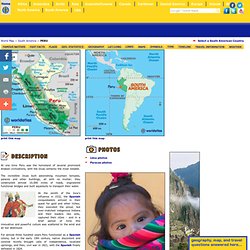
The incredible Incas built astonishing mountain temples, palaces and other buildings, all with no mortar; they constructed almost 10,000 miles of roads, engineered functional bridges and built aqueducts to transport their water. At the zenith of the Inca's influence in 1532, the Spanish conquistadors arrived in their quest for gold and other riches; they executed the proud, but over-matched indigenous Indians and their leaders like ants, captured their cities - and in a brief period of time this innovative and powerful culture was scattered to the wind and all but destroyed.
For almost three hundred years Peru functioned as a Spanish colony, but in the early 19th century, native discontent and colonist revolts brought calls of independence, localized uprisings, and then, civil war in 1821, with the Spanish finally defeated in 1824. Encyclopedia - Britannica Online Encyclopedia.
Religion, Children of the Sun. Children of the Sun The Inca worshipped many gods and goddesses.
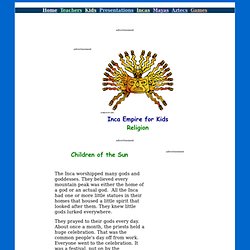
They believed every mountain peak was either the home of a god or an actual god. All the Inca had one or more little statues in their homes that housed a little spirit that looked after them. They knew little gods lurked everywhere. They prayed to their gods every day. Ancient Incas Gold Smelting for Jewelry. Ancient Gold Smelting!
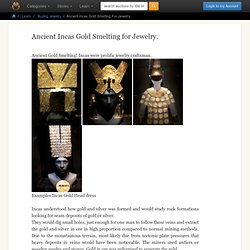
Incas were prolific jewelry craftsman. Examples Incas Gold Head dress Incas understood how gold and silver was formed and would study rock formations looking for seam deposits of gold or silver.They would dig small holes, just enough for one man to follow these veins and extract the gold and silver in ore in high proportion compared to normal mining methods. Due to the mountainous terrain, most likely due from tectonic plate pressures that heavy deposits in veins would have been noticeable. The miners used antlers or wooden spades and stones. The gold was found in rivers and known as alluvial gold. The Incas were good farmers and warriors and only extracted the easy to obtain gold. After the mining the bedrock was pulverised by mortar or heavy rocks such as granite which was denser and harder so the ore broke down easily and was then carted to Incas smelters.
Terrace Farming: A Unique Agricultural Solution. Terrace Farming: A Unique Agriculture Solution Another way that people adapt to their environment is terrace farming.
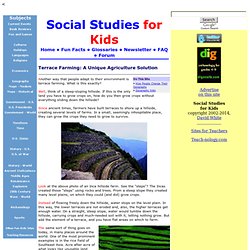
What is this exactly? Well, think of a steep-sloping hillside. If this is the only land you have to grow crops on, how do you then grow crops without everything sliding down the hillside? Since ancient times, farmers have built terraces to shore up a hillside, creating several levels of farms. The Incas for Kids - Terrace Farming. Nobody went hungry in the Inca empire.
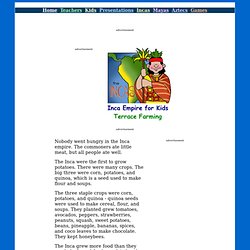
The commoners ate little meat, but all people ate well. Inca Art. Home - Inca Civilization - Inca Art The Legacy of Incan Pottery and Art The legendary Incas of Peru have been likened to the Romans for the innovations they created during their reign, especially when it comes to agriculture, architecture and construction.

However, outside of the marvel that is Machu Picchu, the major ruins left behind after their near extinction at the hands of the explorer Pizarro, Incan art is the most recognizable trace left to us of their remarkable foresight and skills. Inca Art - Background. Inca Clothing. Inca clothing was mainly warm in the highlands and it was made from llama, alpaca and vicuña wool.

Inca officials used to wear stylish tunics to show their status. Women used to wear ankle length skirts, garments, and grass shoes, they were in charge of making the clothes for the men and for themselves. Wealthy incas could wear a specially woven cloth called CUMBI made of baby Alpaca, it was value as gold. Poorest members clothing was quiet plain. Apart from the tunic, a person of importance wore a llawtu, a bunch of cords wrapped around the head. Inca men used to wear tunics which were knee length, grass shoes or leather sandals, headbands, headdresses, belts and bags. It looks like the inca goverment used to control the clothing given to their society, some of them would get one or two outfits and they would wear them literally until worn out.
In our library. 10 Most Impressive Ancient Inca Ruins. The Inca civilization arose from the highlands of Peru in the early 13th century. Starting from 1438, they began conquering lands surrounding the Inca heartland of Cuzco, creating the largest empire in pre-Columbian America. The coming of the Spanish conquistadors in 1532 marked an end to the short-lived Inca Empire. What remains of their civilization is limited as the conquistadors plundered what they could. But visitors can still gain an appreciation of how advanced the Inca were from the amazing ancient Inca ruins found in the highlands of South America. 10Moray Moray is an Incan agricultural laboratory that was likely used to cultivate resistant and hearty varieties of plants high in the Andes. 9Winay Wayna The Inca site of Winay Wayna is built into a hillside overlooking the Urubamba River. 8Coricancha.
Machu Picchu.